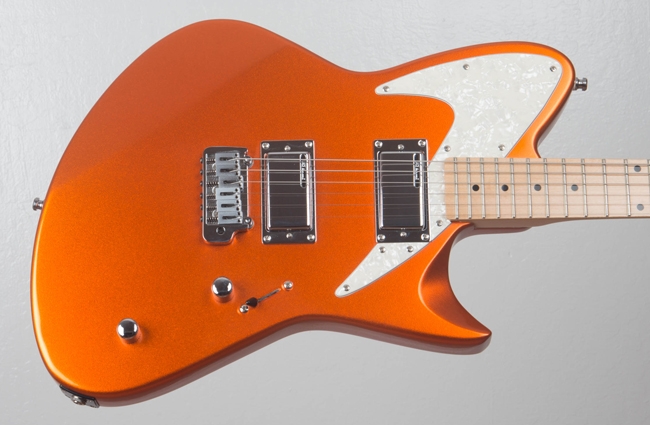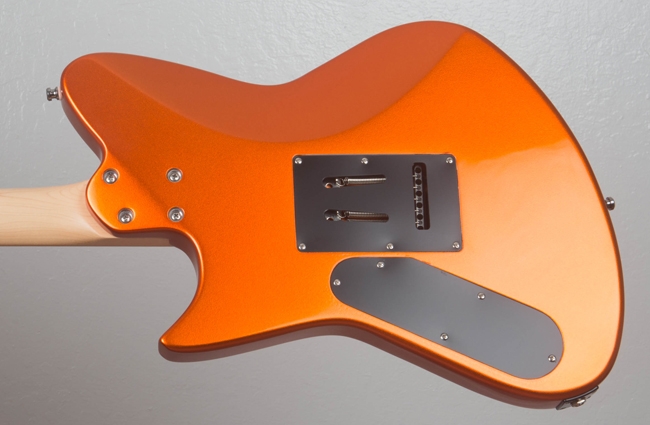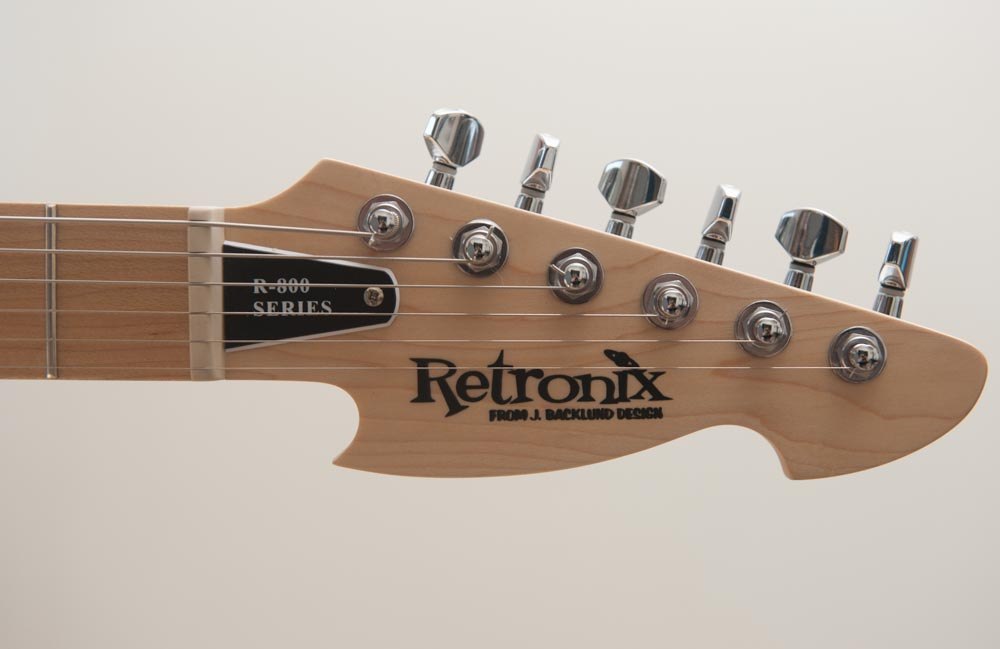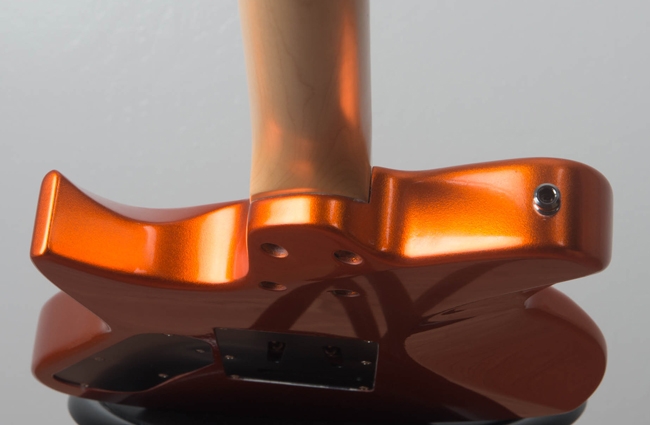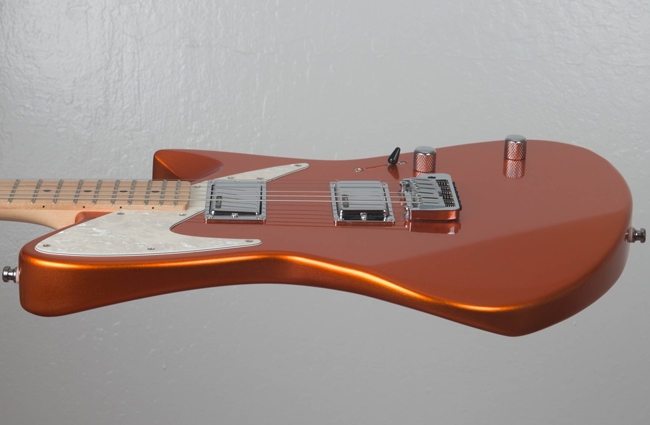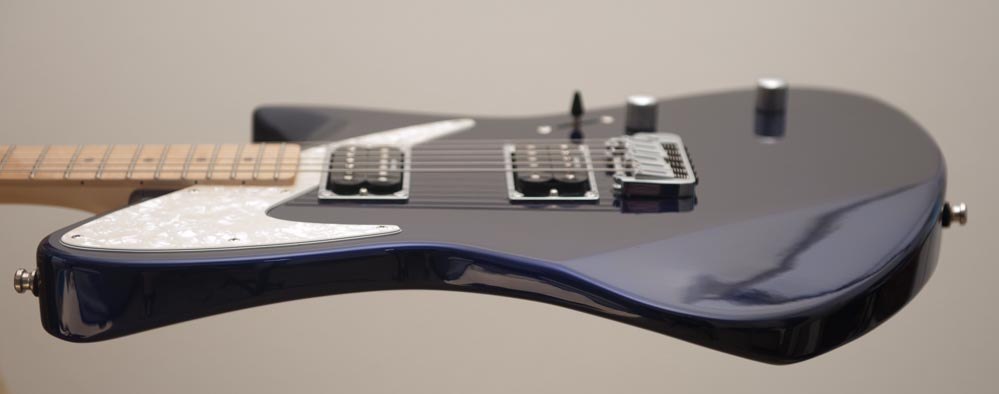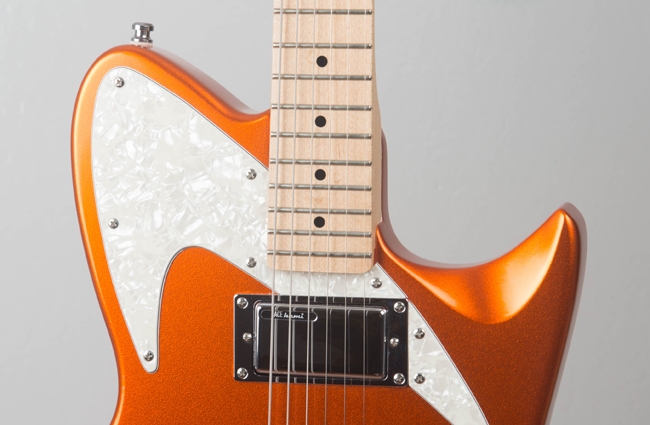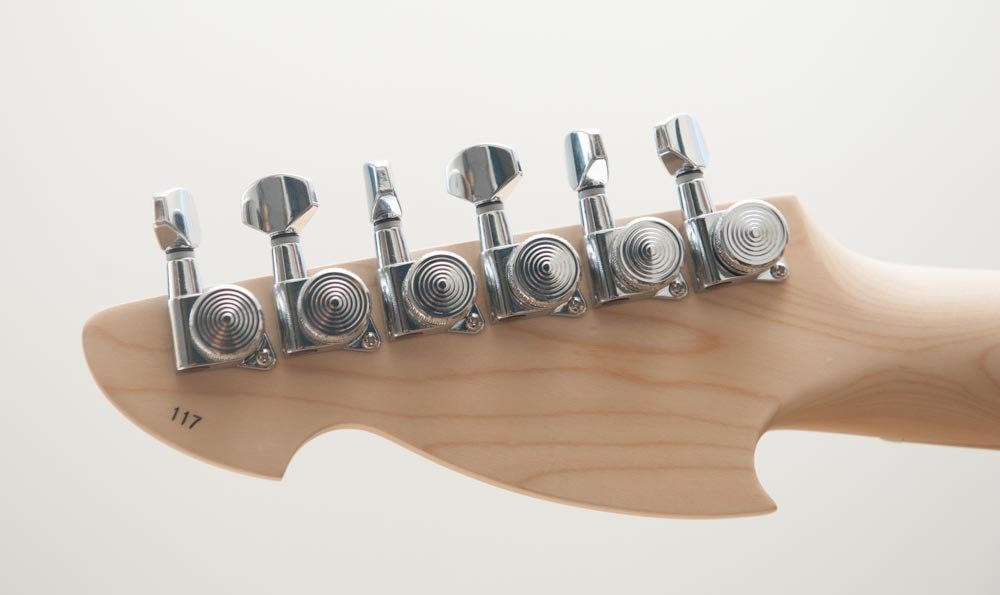J. Backlund Retronix R-800
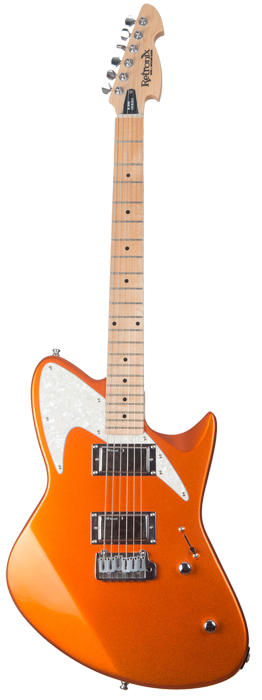 Year: 200X
Year: 200X
Finish: Candy Tangerine (was Cobalt Blue)
Origin: Korea
Price Paid: $500
Mods: Schaller straplocks
Acquired: 2013
Still owned: Yes
The Story:
Getting a new guitar is like adopting a cat from the shelter. Go in, play with it, see if it likes you; if you’re compatible, maybe you’ll become pals and give it a good home. So imagine my trepidation when I bought a guitar through Kickstarter.
I had never heard of J. Backlund Guitars before, but one look at their instruments had me salivating. But the price — about $4000 for the amazing JBD-400 — made them completely unattainable. That’s where Kickstarter came in, as the company wanted to make affordable versions of their designs in Korea and sell them under the Retronix imprint for much more reasonable prices, under $1000. Support their project, and you could score one of the first ones off the line for just $500. I backed it, then got cold feet at the last minute (having just bought the Mira was a major factor) and rescinded my pledge.
Then I felt like crap. Not only was that Retronix just the kind of sexy, offbeat, space-age, offset, candy-colored guitar I really dig, but I really liked the idea of supporting this small boutique shop as it tried to expand its business. And sure enough, they didn’t raise as much as they needed.
A few weeks later, the company realized they didn’t need anywhere near that much money to start production, so they relisted the project, and I jumped on again. The guitars would be ready by March 2013, so with just six months to wait (and a Mira to sell in the meantime), I figured this was meant to be.
I had trouble picking a color; they had metallic variants of traditional Fender shades like Shell Pink and Surf Green, but I was drawn to the Metallic Purple and Cobalt Blue. I had hoped for more photos showing different angles and lighting (Kat has spoiled me) but I settled on purple with a maple neck and a hardtail bridge. Then by the time I had to actually fill out the backer survey, I switched to Cobalt Blue with a trem! I figured I could deck or block the Fender-style trem easily, and I didn’t want to risk living with a wraparound bridge that I didn’t like.
The guitar didn’t arrive until the last week of August 2013, so they were a few months later than their shipping goal, but they made up for it with lots of extras. No case was ever promised, but sure enough, it arrived in a hardshell case built to the R-800’s aggressive shape, and further included lots of case candy — picks, a string winder, a polish cloth, and a nylon strap, all Retronix-branded. Those were all extra, unexpected perks that made me feel appreciated for being a patient Kickstarter backer. These guitars later sold directly from J. Backlund for $800, so I definitely feel like I got a deal and it was worth the wait. It also came set up for .010s and ready to play, having been thoroughly inspected by the team in Tennessee. (Unfortunately, Retronix as a brand was short-lived. Backlund has since partnered with Eastwood to bring their designs to the masses. They are producing the more aggressive and therefore more desirable at higher prices than the Retronix models, but the 800 could well be put into production again.)
My only major gripe was the finish. They called this finish Cobalt Blue, but I saw another backer describe it as “blurple,” which in addition to being funny, feels more accurate to me. It looked nearly black unless the light hit it correctly, at which it turned very deep purple. Clearly not the blue they showed on the prototype, and not even on par with the one cobalt image they shared before launch. After thinking about it for a while, I contacted Greg Philpott at Orbiter Guitars and asked if he’d be up for a refinish job. He was, and we discussed a few bold color options before I decided it should be “orange soda orange,” which Greg interpreted as House of Kolor Candy Tangerine over a silver metallic basecoat. Greg also confirmed I wasn’t crazy — when he sanded it down, he found they’d put a coat of pearl purple over the cobalt. There are some in-progress pics here if you’re curious. The refinish took several months due to the weather and various life interruptions, but came out absolutely stunning, as the photos show!
Interestingly, this has a two-piece maple neck — no skunk stripe, built just like a rosewood fretboard but capped with maple instead. It was good enough for Eddie Van Halen to use on his infamous Frankenstein guitar, it’s good enough for me, plus I’ve since noticed the same construction on the P-Bass. I like the feel of the satin neck with a gloss fingerboard, too. The neck carve is a little fuller than my usual preference, but still very Fendery and comfortable, with the benefit of a back-tilt headstock. Even though I’m not an aggressive player, I am happy to have locking tuners, and I currently have a tentative truce with the floating tremolo — but I keep wanting to block it.
The pickups sounded just fine — “Dracowyre” is Backlund’s own brand — but I had Greg swap them out for chrome-faced Lace Hemi humbuckers, which I adore both tonally and aesthetically. If we were pimping out the guitar anyway, I wanted more chrome! Greg did preserve the original wiring scheme, which was an unusual five-way switch affair: Positions 1, 3 and 5 are traditional Les Paul neck/both/bridge settings, while 2 and 4 are single-coil tapped. It’s plenty versatile.
Also, after committing to the orange guitar, we wound up buying an orange house. We finally were able to invest in our own home, and for whatever reason, the previous tenants — to prepare it for sale, no less — painted over the white/gray exterior with jack-o’-lantern orange. Totally accidental, I swear — but I love them both.
